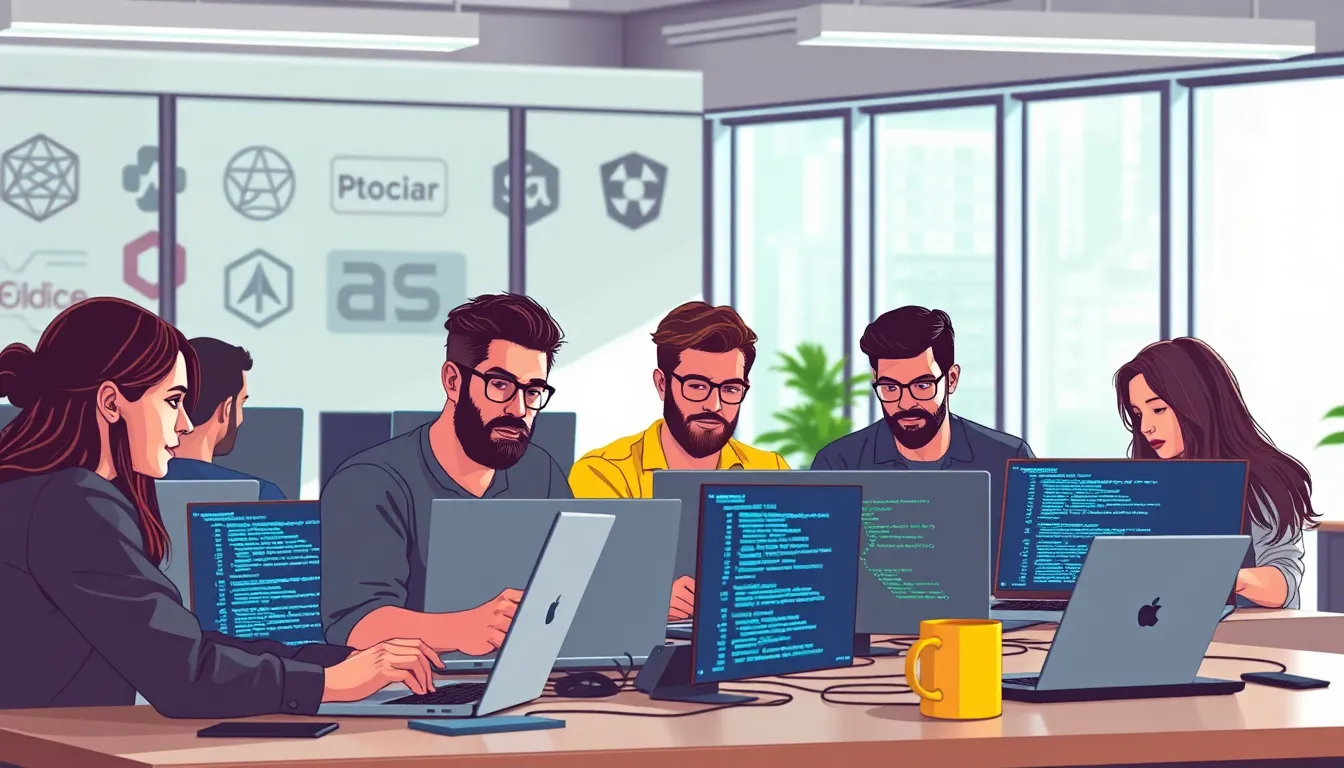In a world where apps rule the digital landscape, coding them can feel like unlocking a secret level in a video game. With every line of code, developers conjure up magic, turning wild ideas into user-friendly experiences. But let’s be honest—app coding isn’t just for tech wizards with thick glasses and caffeine-fueled nights. It’s for anyone who dreams of bringing their vision to life, whether that’s a quirky game or a life-changing productivity tool.
Imagine being the mastermind behind the next big app while sipping your favorite coffee. Sounds enticing, right? App coding opens doors to creativity, innovation, and maybe even a little fame. So, buckle up and get ready to dive into the exciting world of app coding, where every keystroke could lead to your next big breakthrough.
Table of Contents
ToggleOverview of App Coding
App coding encompasses various techniques and programming languages that developers use to create software applications. Many popular languages, such as Java, Swift, and Python, serve as foundations for mobile and web applications. Each language has its strengths; for instance, Swift’s conciseness suits iOS app development, while Java remains a go-to for Android.
Development processes vary across platforms. Developers often use integrated development environments (IDEs) to streamline coding tasks, making it easier to test and debug applications. User interfaces (UIs) play a crucial role in app design; thus, understanding frameworks like React Native or Flutter improves the overall experience.
Designers and developers collaborate to ensure functionality aligns with user needs. This teamwork fosters creative solutions and enhances app performance. Regular updates keep applications fresh, reinforcing user engagement by introducing new features and fixing bugs.
Agile methodologies frequently guide app coding projects, emphasizing iterative progress and adaptability. Small teams can leverage daily stand-ups to discuss progress and challenges, fostering communication that enhances project efficiency. Continuous integration and deployment practices expedite testing and delivery, keeping production schedules on track.
Tutorials and online courses offer valuable resources to aspiring coders. Many platforms provide step-by-step guides on app development, catering to different skill levels. Communities, such as GitHub and Stack Overflow, serve as support networks; they connect developers, allowing them to share knowledge and troubleshoot issues collectively.
Exploring app coding opens doors to innovation. By mastering this skill, individuals can create tools that fulfill personal visions or address broader user needs, ultimately contributing to technological advancements.
Key Programming Languages for App Development

App development relies on various programming languages, each suited for different challenges. Understanding these languages enables developers to choose the right tools for their projects.
Native vs. Cross-Platform Languages
Native languages, such as Swift for iOS and Kotlin for Android, offer optimized performance and seamless integration with device features. Cross-platform languages, including React Native and Flutter, allow developers to write a single codebase for multiple platforms. Each option has advantages, making the choice dependent on project requirements and target audience.
Popular Languages and Their Use Cases
Java remains popular for Android app development due to its versatility and extensive libraries. Swift excels in crafting responsive iOS applications with a modern syntax. Python simplifies back-end development, making it an ideal choice for applications requiring data analysis. JavaScript, widely utilized for web applications, works effectively with frameworks like React and Angular. Understanding these languages helps developers select the best fit for their app development needs.
Tools and Frameworks for App Coding
App coding requires the right tools and frameworks to enhance productivity and ensure quality. Developers leverage various resources to create effective applications.
Integrated Development Environments (IDEs)
Integrated Development Environments (IDEs) provide essential functionalities that streamline the coding process. Popular options include Visual Studio Code, Xcode, and Android Studio. Each of these IDEs offers features like syntax highlighting, debugging tools, and version control integration. Developers maximize efficiency by using IDEs that support their chosen programming languages. For instance, Xcode is optimal for Swift, while Android Studio specializes in Kotlin for Android apps. Using an IDE aids in maintaining organization and improving code quality.
Frameworks to Consider
Frameworks play a crucial role in simplifying app development tasks. React Native and Flutter are among the most popular choices. React Native enables developers to build mobile applications using JavaScript, while Flutter utilizes Dart, offering a high-performance experience. Each framework allows for code sharing across platforms, reducing development time and resources. Developers should evaluate their project needs before selecting a framework. Choosing the right framework can lead to a more intuitive and efficient development process.
Best Practices in App Coding
Emphasizing best practices in app coding improves software quality and user experience. These strategies streamline development and enhance collaboration.
Writing Clean and Maintainable Code
Writing clean code enhances readability for future developers. Use descriptive variable names to convey their purpose clearly. Organize code into logical structures, such as functions and classes, making navigation easier. Comment on complex code segments to provide necessary context. Following consistent formatting guidelines, like indentation and spacing, helps maintain organization. Familiarity with design patterns benefits efficiency in solving common problems. Regularly refactoring code also aids in simplifying complex sections, ensuring long-term maintainability.
Importance of Testing and Debugging
Testing and debugging play vital roles in ensuring an app’s performance. Automated testing frameworks allow for consistent checks across different code versions. Implement unit tests to verify individual components work correctly. Conduct integration testing to confirm different parts of the app function together seamlessly. Debugging tools help identify and rectify issues rapidly. Regular testing prevents long-term problems and enhances user satisfaction. Making testing a priority in the development process ultimately leads to higher-quality apps.
Future Trends in App Coding
Future trends in app coding reflect rapid shifts toward innovation and accessibility. Technologies like artificial intelligence, augmented reality, and machine learning are changing how developers create apps. AI streamlines tasks such as bug detection and code generation, enhancing developer efficiency. Augmented reality enriches user interactions, allowing users to engage more deeply with applications. Machine learning supports data analysis, enabling tailored user experiences.
Emerging Technologies
Emerging technologies shape the app coding landscape significantly. Blockchain offers enhanced security and transparency for transactions within apps. Progressive web apps provide improved user experiences by blending web and mobile app features. 5G connectivity allows for faster data transfer, enabling complex functionalities in apps that were once impractical. Moreover, quantum computing has the potential to revolutionize app performance, handling calculations previously deemed impossible.
Shift Towards No-Code and Low-Code Solutions
No-code and low-code solutions are transforming app development by promoting accessibility. These platforms empower individuals without extensive coding knowledge to create functional applications. Users can quickly develop prototypes, reducing the time from concept to deployment. Businesses benefit from decreased development costs and increased agility. Enhanced collaboration between teams often occurs when more people participate in the development process, fostering innovation and creativity.
App coding opens the door to endless possibilities for anyone willing to explore their creativity. With a variety of programming languages and tools available it’s easier than ever to start building applications that can make an impact. As technology continues to evolve the importance of staying updated with new trends and practices becomes increasingly clear.
Embracing methodologies like agile and leveraging supportive communities can significantly enhance the development experience. By prioritizing clean code and user-centric design developers can create apps that not only function well but also resonate with users. As the landscape shifts towards no-code and low-code solutions the future of app development looks bright for aspiring creators everywhere.






